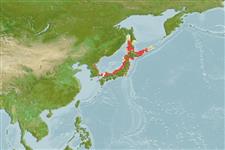Bivalvia |
Pectinida |
Pectinidae
Environment: milieu / climate zone / depth range / distribution range
Ecology
Benthic; depth range 0 - 100 m (Ref. 356), usually 2 - 80 m (Ref. 75831). Temperate, preferred 17°C (Ref. 107945); 56°N - 35°N, 127°E - 151°E
Northwest Pacific: from the Sea of Japan (North and South Korea and Russia) to Pacific coast of Japan (35°N) to the Sea of Okhotsk, southern Sakhalin and southern Kuril Islands. Introduced in Northeast Atlantic and the Mediterranean.
Length at first maturity / Size / Weight / Age
Maturity: Lm ? range ? - ? cm Max length : 25.0 cm SHL male/unsexed; (Ref. )
Occurs on sandy, silty and muddy bottoms. Suspension feeder (Ref. 106923).
Life cycle and mating behavior
Maturity | Reproduction | Spawning | Eggs | Fecundity | Larvae
Life cycle: Embryos develop into free-swimming trocophore larvae, succeeded by the bivalve veliger, resembling a miniature clam (Ref. 833).
SAUP Database 2006 SAUP Database. www.seaaroundus.org. (Ref. 356)
IUCN Red List Status
(Ref. 130435: Version 2025-1)
CITES status (Ref. 108899)
Not Evaluated
Not Evaluated
Threat to humans
Human uses
Fisheries: commercial; aquaculture: commercial
FAO - Aquaculture: production, species profile; Fisheries: landings | FishSource | Sea Around Us
Tools
More information
PhysiologyOxygen consumption
Human RelatedStamps, coins, misc.
Internet sources
Estimates based on models
Preferred temperature
(Ref.
115969): 1 - 18.5, mean 5.1 (based on 470 cells).
Resilience
High, minimum population doubling time less than 15 months (K=0.87-0.98).
Fishing Vulnerability
Low vulnerability (13 of 100).
Climate Vulnerability
High vulnerability (58 of 100).
Price category
Unknown.
